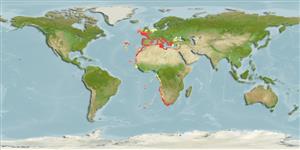Common names from other countries
Environment: milieu / climate zone / depth range / distribution range
Écologie
; profondeur 3 - 871 m (Ref. 78235), usually 50 - 450 m (Ref. 8). Subtropical; 58°N - 41°S, 35°W - 38°E
Eastern Atlantic and the Mediterranean: from Ireland to Senegal, including the Azores and Canary Islands, and the entire Mediterranean. Temperate to tropical.
Length at first maturity / Taille / Poids / Âge
Maturity: Lm ? range ? - ? cm Max length : 11.2 cm TL mâle / non sexé; (Ref. 8)
Known from pelagic depths between 100 to 200 m (Ref. 92299). Occurs on muddy and sandy bottoms on the shelf and upper slope. Buries in the mud during the day and emerges at night (Ref. 80202). Feeds on benthic invertebrates living on soft bottom substrates like polychaetes, bivalves, gastropods and echinoderms (Ref. 106588).
Life cycle and mating behavior
Maturité | Reproduction | Frai | Œufs | Fécondité | Larves
Members of the order Decapoda are mostly gonochoric. Mating behavior: Precopulatory courtship ritual is common (through olfactory and tactile cues); usually indirect sperm transfer.
Holthuis, L.B. 1980. (Ref. 8)
Statut dans la liste rouge de l'IUCN (Ref. 130435)
statut CITES (Ref. 108899)
Not Evaluated
Not Evaluated
Utilisations par l'homme
Pêcheries: intérêt commercial mineur
| FishSource |
Outils
Sources Internet
Estimates based on models
Preferred temperature
(Ref.
115969): 9.8 - 17, mean 13.7 (based on 593 cells).
Résilience
Haut, temps minimum de doublement de population inférieur à 15 mois (K=0.5-0.65).
Vulnérabilité
Low vulnerability (10 of 100).
Catégorie de prix
Unknown.
